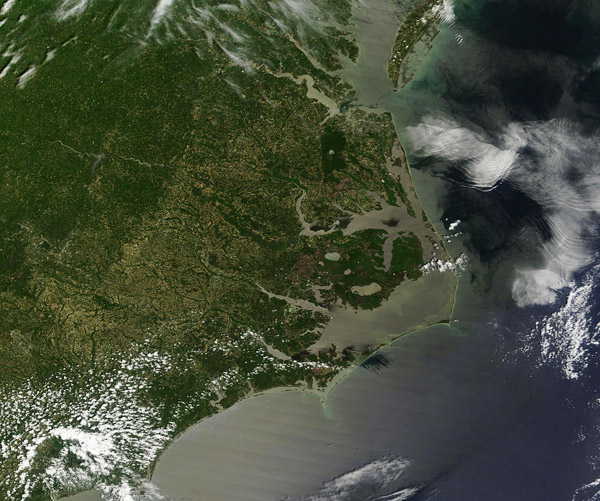Images
May 18, 2016 - The Carolinas
Tweet
Kp>
On May 14, 2016, NASA’s Terra satellite flew over the southeastern United States allowing the Moderate Resolution Imaging Spectroradiometer (MODIS) to capture a true-color image focused on the Carolinas.
In 1663, King Charles II of England granted the Charter of Carolina to eight “right trusty, and right well beloved” men, making them the Lord Proprietors of Carolina. Over time differences emerged in the new land, particularly in methods of agriculture and regional dependency on slavery. In 1712 a formal split occurred in the colony, creating North Carolina and South Carolina.
A small bit of Virginia can be seen at the north of this image, including the mouth of the Chesapeake Bay in the northeast. Near the mouth of the Chesapeake Bay the muddiness of the James River in Virginia attests to the rainy spring weather experienced across the region.
A ribbon of islands outlines the eastern coast of North Carolina. Known as the Outer Banks, this strip of barrier islands are a popular tourist destination. Although vulnerable to erosion, winds, and storms, the wide expanses of beachfront have long drawn people to them. Kitty Hawk, the site of the Wright brother’s first flight, is located on the Outer Banks, as is the Lost Colony (Roanoke Colony), where the first English baby was born in America. Cape Hatteras sits at the eastern-most point on the outer banks.
The Outer Banks are separated from mainland North Carolina by two major sounds: the Albemarle Sound in the north and the larger Pamlico Sound in the south. A “sound” is a term for a salt-water lagoon. The Pamlico Sound is about 80 mi (129 km) long and 15-20 mi (24-32 km) wide. Three inlets feed the Pamlico Sound, cutting across the Outer Banks communicating with the Atlantic Ocean. While the Atlantic Ocean just offshore of the Banks can drop to 20 – 50 feet (6-15 m) depth, the Pamlico Sound has an average depth of only about 5-6 feet (1.5 to 1.8 m).
South Carolina sits south of North Carolina, with a less complex coastline. The Savannah River (south of this image) marks the boundary of South Carolina and Georgia.
Image Facts
Satellite:
Terra
Date Acquired: 5/14/2016
Resolutions:
1km ( B), 500m (249.6 KB), 250m (625.5 KB)
Bands Used: 1,4,3
Image Credit:
Jeff Schmaltz, MODIS Land Rapid Response Team, NASA GSFC
Tweet
Kp> On May 14, 2016, NASA’s Terra satellite flew over the southeastern United States allowing the Moderate Resolution Imaging Spectroradiometer (MODIS) to capture a true-color image focused on the Carolinas.
In 1663, King Charles II of England granted the Charter of Carolina to eight “right trusty, and right well beloved” men, making them the Lord Proprietors of Carolina. Over time differences emerged in the new land, particularly in methods of agriculture and regional dependency on slavery. In 1712 a formal split occurred in the colony, creating North Carolina and South Carolina.
A small bit of Virginia can be seen at the north of this image, including the mouth of the Chesapeake Bay in the northeast. Near the mouth of the Chesapeake Bay the muddiness of the James River in Virginia attests to the rainy spring weather experienced across the region.
A ribbon of islands outlines the eastern coast of North Carolina. Known as the Outer Banks, this strip of barrier islands are a popular tourist destination. Although vulnerable to erosion, winds, and storms, the wide expanses of beachfront have long drawn people to them. Kitty Hawk, the site of the Wright brother’s first flight, is located on the Outer Banks, as is the Lost Colony (Roanoke Colony), where the first English baby was born in America. Cape Hatteras sits at the eastern-most point on the outer banks.
The Outer Banks are separated from mainland North Carolina by two major sounds: the Albemarle Sound in the north and the larger Pamlico Sound in the south. A “sound” is a term for a salt-water lagoon. The Pamlico Sound is about 80 mi (129 km) long and 15-20 mi (24-32 km) wide. Three inlets feed the Pamlico Sound, cutting across the Outer Banks communicating with the Atlantic Ocean. While the Atlantic Ocean just offshore of the Banks can drop to 20 – 50 feet (6-15 m) depth, the Pamlico Sound has an average depth of only about 5-6 feet (1.5 to 1.8 m).
South Carolina sits south of North Carolina, with a less complex coastline. The Savannah River (south of this image) marks the boundary of South Carolina and Georgia.
Image Facts
Satellite:
Terra
Date Acquired: 5/14/2016
Resolutions:
1km ( B), 500m (249.6 KB), 250m (625.5 KB)
Bands Used: 1,4,3
Image Credit:
Jeff Schmaltz, MODIS Land Rapid Response Team, NASA GSFC




